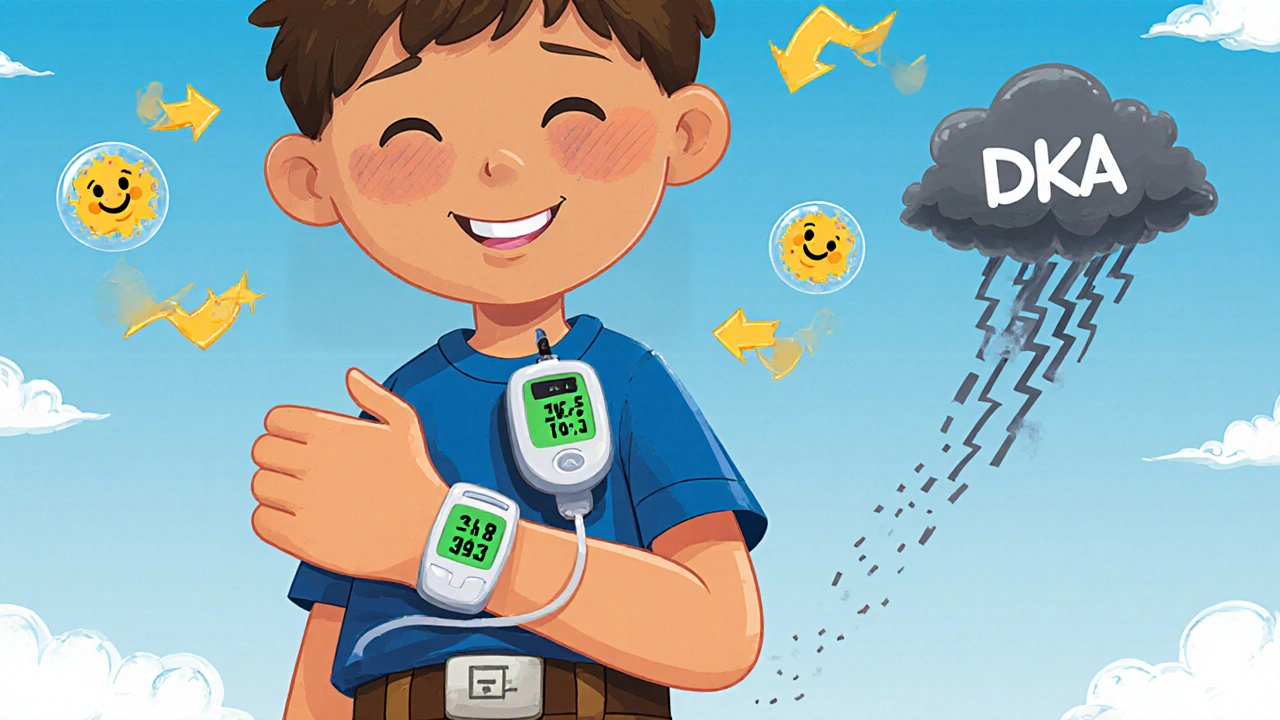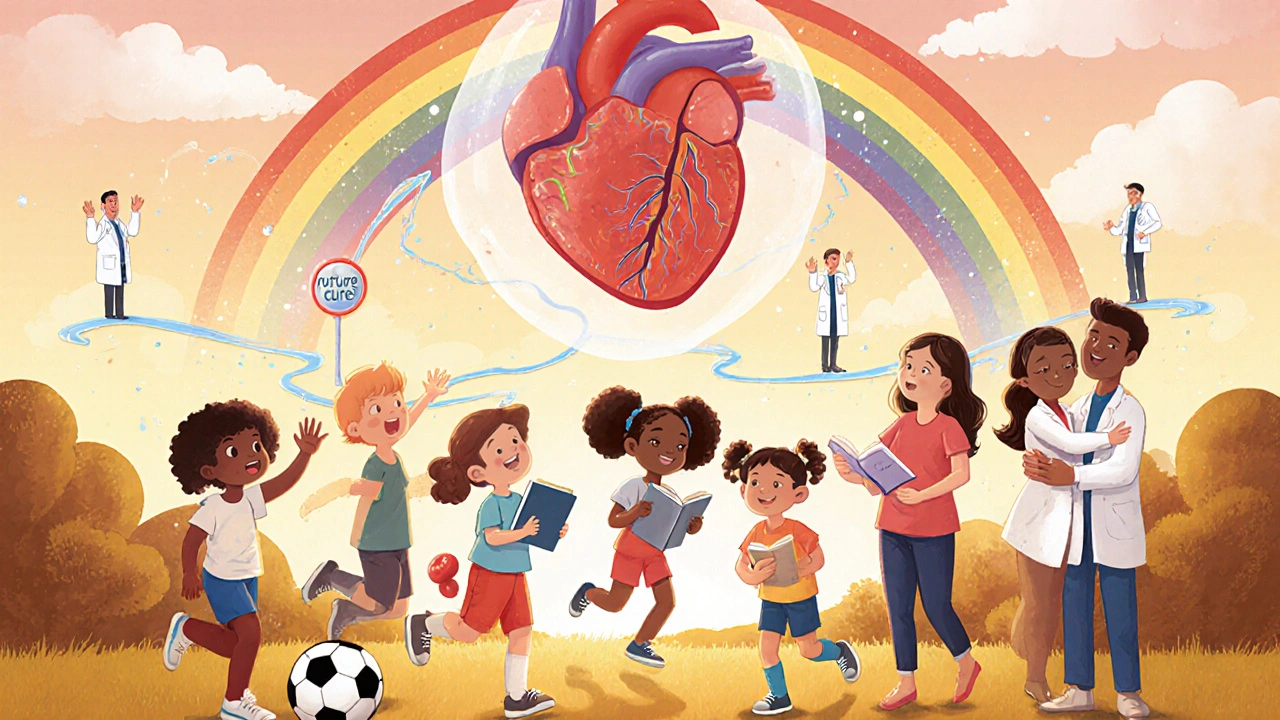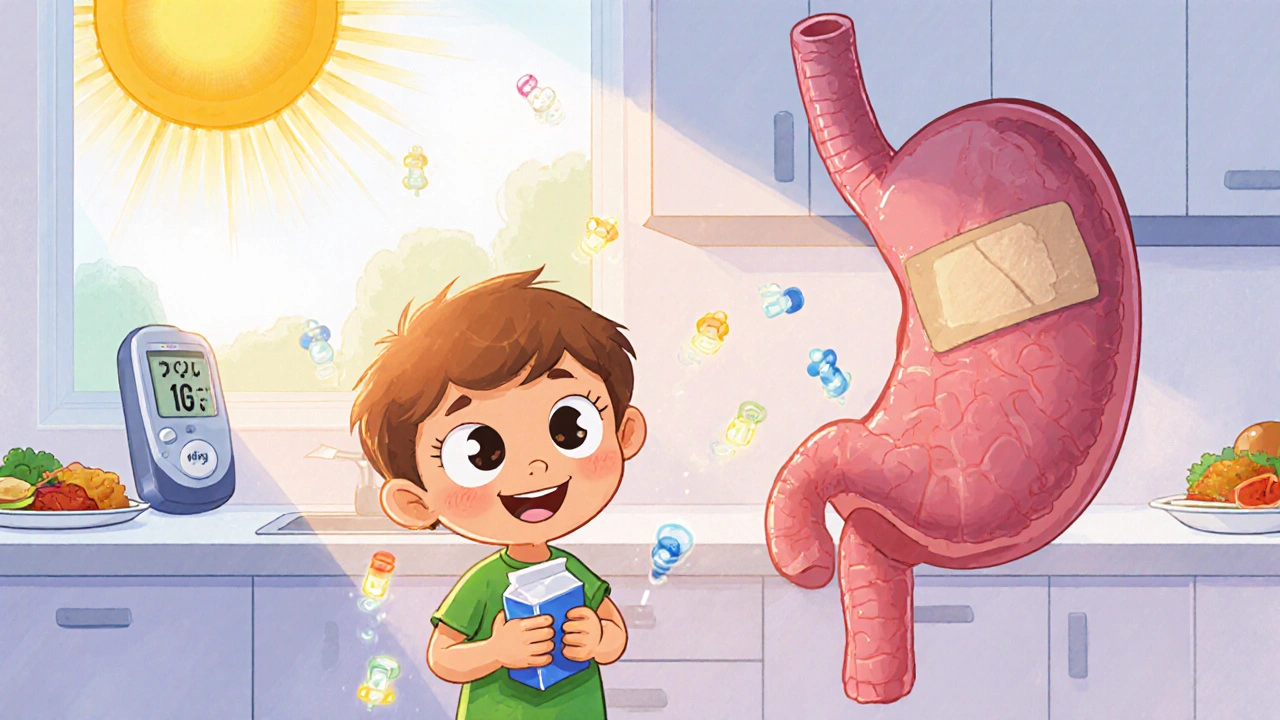When your body stops making insulin, life changes fast. Type 1 diabetes doesn’t wait for a warning. One day you’re fine; the next, you’re drinking gallons of water, peeing constantly, and losing weight even though you’re starving. This isn’t just about sugar-it’s about survival. Without insulin, your cells starve while your blood turns acidic. The good news? We know how to manage it. And today’s tools are better than ever.
What Happens in Type 1 Diabetes?
Type 1 diabetes is an autoimmune disease. Your immune system, which normally fights germs, mistakenly attacks the insulin-producing beta cells in your pancreas. Once those cells are gone, you can’t make insulin anymore. It’s not caused by eating too much sugar or being overweight. It’s not preventable. And it can strike at any age-even in adults, though it’s often diagnosed in kids and teens.
Without insulin, glucose from food can’t enter your cells for energy. Instead, it builds up in your blood. Your body tries to flush it out through urine, which is why you’re always thirsty and peeing. Fat and muscle break down for fuel, leading to rapid weight loss. If left unchecked, your blood becomes too acidic, triggering diabetic ketoacidosis (DKA)-a life-threatening emergency that can develop in less than 24 hours.
Classic Symptoms: Don’t Ignore These Signs
The signs of type 1 diabetes come on fast. Unlike type 2, which creeps in over years, type 1 often hits like a storm:
- Extreme thirst-you can’t quench it, no matter how much you drink.
- Frequent urination-waking up multiple times at night to go.
- Unexplained weight loss-even if you’re eating more than usual.
- Constant fatigue-your body can’t use glucose, so you’re running on empty.
- Blurred vision-high blood sugar swells the lenses in your eyes.
- Increased hunger-your cells are starving even though you’ve eaten.
- Slow-healing cuts or frequent infections-high glucose weakens your immune response.
- Dry mouth and fruity-smelling breath-a red flag for ketones building up.
Some people, especially adults, may have milder symptoms at first. That’s dangerous. It delays diagnosis. The CDC warns that DKA can strike without warning. If you or someone you know has these symptoms and they’re worsening quickly, get tested-now.
How Is Type 1 Diabetes Diagnosed?
Diagnosis isn’t just about one blood test. It’s a combination of results and context. Doctors look for:
- A1C test: A reading of 6.5% or higher on two separate tests confirms diabetes. This measures your average blood sugar over the past 2-3 months.
- Fasting plasma glucose: After 8+ hours without food, a level of 126 mg/dL or higher means diabetes.
- Random plasma glucose: If your blood sugar is 200 mg/dL or higher and you have symptoms, that’s enough to diagnose diabetes.
- Oral glucose tolerance test: After drinking a sugary solution, your blood sugar is checked after 2 hours. A result over 200 mg/dL confirms diabetes.
But here’s the key: These tests tell you if you have diabetes. To know it’s type 1, doctors need more. Autoantibody tests are critical. The most common is GAD65. If that’s positive, it’s almost certainly type 1. If not, they check for IA2 or ZNT8 antibodies. These markers show your immune system is attacking your pancreas.
C-peptide levels also help. This substance is made at the same time as insulin. Low C-peptide means your body isn’t making insulin-classic type 1. In type 2, C-peptide is usually high because the body is still producing insulin, just not using it well.
If symptoms are severe, doctors will also test for ketones in your blood or urine. High ketones mean your body is burning fat for fuel-dangerously close to DKA.

Insulin Therapy: The Lifeline for Type 1 Diabetes
You can’t live without insulin. That’s the hard truth. But insulin therapy today is far more flexible, precise, and less invasive than it was 20 years ago.
There are two main approaches: multiple daily injections (MDI) and insulin pumps.
MDI (Basal-Bolus Therapy) means taking two types of insulin every day:
- Long-acting insulin (like glargine or detemir): One or two shots a day to cover your baseline needs.
- Rapid-acting insulin (like lispro, aspart, or glulisine): Taken before meals to handle the sugar from food.
You’ll need to calculate how much insulin to take based on your blood sugar and how many carbs you’re eating. Most people check their blood sugar 4 to 10 times a day with fingersticks. It’s a lot of work-but it works.
Insulin pumps (continuous subcutaneous insulin infusion, or CSII) are small devices worn on the body that deliver insulin through a tiny tube under the skin. They give a steady drip of rapid-acting insulin all day (basal rate) and let you press a button to deliver extra doses (bolus) at meals.
Modern pumps don’t just deliver insulin-they talk to your glucose monitor. Hybrid closed-loop systems like the Medtronic MiniMed 780G or Tandem t:slim X2 with Control-IQ can automatically adjust insulin doses based on real-time glucose readings. These systems have been shown to increase time spent in the healthy blood sugar range (70-180 mg/dL) from 50% to 70-75%.
Target Blood Sugar Levels and A1C Goals
The goal isn’t perfection-it’s safety and stability. The American Diabetes Association recommends:
- Before meals: 80-130 mg/dL
- After meals (2 hours): Below 180 mg/dL
- A1C target: Under 7% for most adults
But these aren’t one-size-fits-all. For older adults, people with heart disease, or those who get low blood sugar often, a target of 7.5% to 8% might be safer. For kids and teens, tighter control is often encouraged to protect long-term health. Your doctor will help you find your personal sweet spot.
Monitoring Beyond Blood Sugar
Managing type 1 diabetes isn’t just about glucose. Your body is under constant stress. Regular checkups include:
- Cholesterol and triglycerides: High blood sugar damages blood vessels and raises heart disease risk.
- Kidney function: Urine tests for protein (albumin) and blood tests for creatinine.
- Thyroid function: Autoimmune conditions often cluster-type 1 diabetes and thyroid disease are common together.
- Eye exams: Annual dilated eye exams to catch early signs of retinopathy.
- Foot exams: Nerve damage and poor circulation can lead to ulcers and infections.
A1C should be checked every 3 months if your levels aren’t stable or you’ve changed your treatment. If you’re doing well, twice a year is usually enough.

What About New Treatments?
There’s real hope on the horizon.
In late 2022, the FDA approved teplizumab (Tzield), the first drug that can delay the onset of type 1 diabetes in people at high risk. It’s given as a 14-day IV infusion and has been shown to delay diagnosis by over two years on average. It doesn’t cure it-but it buys time.
Stem cell therapies are also advancing fast. Vertex Pharmaceuticals’ VX-880, an experimental treatment using lab-grown insulin-producing cells, has helped people with type 1 diabetes stop using insulin altogether in early trials. At 90 days, 89% of participants were insulin-free. This isn’t widely available yet, but it’s a major step toward a cure.
Life With Type 1 Diabetes: The Daily Reality
People with type 1 diabetes spend 2 to 4 hours a day managing their condition. That’s not counting doctor visits or mental energy. You learn carb counting, insulin-to-carb ratios (often 1 unit per 5 to 30 grams of carbs), correction factors, and how to treat lows.
Hypoglycemia (low blood sugar) is a constant threat. Any reading below 70 mg/dL needs immediate action: 15 grams of fast-acting sugar-glucose tabs, juice, or candy. Wait 15 minutes. Check again. Repeat if needed. Too much insulin, too little food, or too much exercise can trigger it.
Insurance and cost are huge barriers. The average annual cost for someone with type 1 diabetes is over $20,000. Insulin alone makes up nearly a third of that. Even with insurance, out-of-pocket costs for pumps, sensors, and insulin can be crippling.
But here’s what’s true: People with type 1 diabetes live full, active, successful lives. Athletes, parents, engineers, teachers-they all manage it. It’s hard. But it’s manageable. And with today’s tools, it’s getting easier every year.
What You Need to Know Right Now
If you’re newly diagnosed:
- Get into a diabetes education program. Ten to twenty hours of training will save you months of struggle.
- Ask about continuous glucose monitoring (CGM). It reduces A1C by 0.5% to 0.8% compared to fingersticks alone.
- Don’t try to do this alone. Support groups, online communities, and certified diabetes care specialists are lifelines.
- Learn to recognize low blood sugar symptoms: shaking, sweating, confusion, dizziness, rapid heartbeat.
- Carry glucose tabs everywhere. Always.
If you’ve had it for years:
- Review your A1C trends. Are you slipping? Talk to your provider about pump therapy or CGM if you’re not using them.
- Check your feet daily. Nerve damage sneaks up slowly.
- Keep up with eye and kidney screenings. Prevention beats treatment every time.
Can type 1 diabetes be cured?
There is no cure yet, but there are promising treatments in development. Teplizumab can delay onset in high-risk individuals, and stem cell therapies like VX-880 have restored insulin production in early trials. For now, lifelong insulin therapy is required. Research is moving fast, and a cure may be closer than we think.
Is type 1 diabetes the same as type 2?
No. Type 1 is autoimmune-your body destroys insulin-producing cells. Type 2 is metabolic-you still make insulin, but your body doesn’t use it well. Type 1 usually starts suddenly, often in youth. Type 2 develops slowly, often linked to weight and lifestyle. Treatment differs: type 1 always needs insulin; type 2 may be managed with diet, pills, or eventually insulin.
Can you outgrow type 1 diabetes?
No. Once the beta cells are destroyed, they don’t regenerate on their own. Some people may experience a "honeymoon phase" shortly after diagnosis, where the pancreas still makes a little insulin. This can make blood sugar easier to control for weeks or months-but it doesn’t last. Insulin will always be needed.
Do insulin pumps cure type 1 diabetes?
No. Pumps deliver insulin more precisely and reduce the burden of multiple daily shots, but they don’t fix the underlying problem. You still need to monitor glucose, count carbs, and adjust doses. Pumps improve quality of life and outcomes, but they’re a tool-not a cure.
Can a person with type 1 diabetes live a normal life?
Absolutely. People with type 1 diabetes compete in the Olympics, raise families, run businesses, and work in every profession. It requires discipline, planning, and support-but it doesn’t define you. With modern tools like CGMs and hybrid pumps, many achieve near-normal blood sugar levels most of the time. The key is consistency, not perfection.
What’s the biggest mistake people make after diagnosis?
Trying to do everything perfectly right away. Type 1 diabetes is a marathon, not a sprint. Many people burn out trying to hit perfect numbers every day. Focus on safety first: avoid lows, prevent DKA, and learn one skill at a time. Progress over perfection. Your body will thank you.


Just got diagnosed last month. I thought I was just stressed until I passed out at work. Now I’m carrying glucose tabs in my wallet, my shoes, and my damn dog’s leash. It’s insane how fast everything changes. I’m not crying about it-I’m just mad I didn’t know the signs sooner.
One cannot help but observe the epistemological dissonance between public perception and clinical reality regarding type 1 diabetes. The conflation of metabolic dysfunction with behavioral causality persists in popular discourse, despite overwhelming immunological evidence to the contrary. This is not a lifestyle disease-it is a biological betrayal.
Canada’s healthcare system is supposed to be better than this. I paid $800 out of pocket last month for insulin. My cousin in the US? She’s on a waiting list for a pump because her insurance says it’s ‘not medically necessary.’ This isn’t medicine-it’s a fucking lottery.
People say ‘it’s just diabetes’ like it’s a cold. You don’t get to take a day off. You don’t get to forget. I had a birthday party last week-my kid got cake. I got a glucometer and three juice boxes. And I still had to explain to my aunt why I didn’t eat any of it. Again.
You’re not alone. I’ve been living with this for 18 years. The tech is getting better, the community is stronger, and you’re already ahead just by reading this. One step at a time. You’ve got this.
Yeah right, ‘hybrid closed-loop systems’-sounds like a sci-fi movie. I’ve had my pump for 3 years and it still beeps at 3 a.m. because I ate a damn muffin. I’m not a robot. My body isn’t a spreadsheet. They want us to be perfect? Fine. I’ll be perfect… in my dreams.
My daughter was diagnosed at 6. We cried for three days. Now she’s the one reminding me to check my own levels. She’s got a CGM that talks to her smartwatch. She says it’s like having a superhero sidekick. I don’t know how she does it. But I’m so proud.
OMG this is so true!! I just got my first CGM and I’m crying happy tears 😭 I used to have 4-5 lows a week. Now I’m in range 78% of the time. It’s not perfect, but it’s LIFE CHANGING. Also, glucose tabs in the car, purse, and baby stroller. Always.
It is of considerable interest that the prevalence of autoimmune comorbidities-particularly thyroid dysfunction-is markedly elevated in type 1 diabetic populations. One must therefore advocate for a comprehensive endocrine workup at time of diagnosis, as the clinical implications extend beyond glycemic control alone.
I’m from the States. My cousin’s kid got diagnosed last year. He’s 10. Now he’s doing his own shots. He says he’s a ‘diabetes ninja.’ I don’t know what that means, but he’s smiling. So I’m smiling too.
Wait-so teplizumab delays onset by 2 years? Cool. So we’re just buying time until the next miracle? And VX-880? Lab-grown beta cells? Yeah right. Next they’ll tell us we can grow a pancreas in a blender. I’ve seen this movie before. They hype it for 10 years, then it’s ‘too expensive’ or ‘too risky.’ Don’t get your hopes up.
Don’t let anyone tell you you’re ‘not trying hard enough.’ I’ve been doing this for 22 years. I’ve had 3 DKA hospitalizations. I’ve cried in the middle of the grocery store because I forgot my insulin. I’m not perfect. But I’m still here. And that’s enough.
Who funds this research? Big Pharma. They want you dependent. That’s why they’re not curing it. That’s why insulin costs $300 a vial. That’s why they push pumps and CGMs-more profit. They don’t want you free. They want you buying. Always.
My brother has type 1 since age 8. Now he’s a software engineer in Bangalore. He uses an open-source loop system he coded himself. He says, ‘I don’t wait for the future-I build it.’ That’s the spirit. You’re not broken. You’re adapting. And that’s strength.